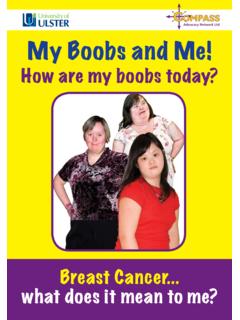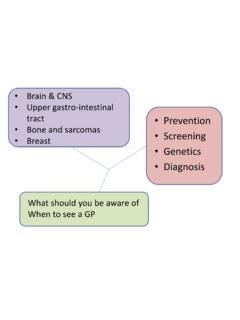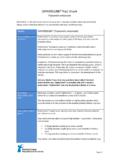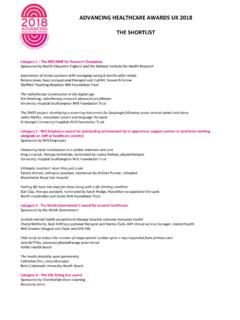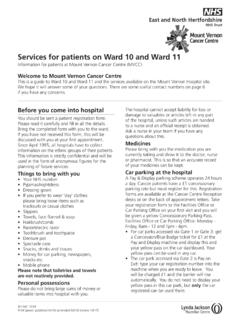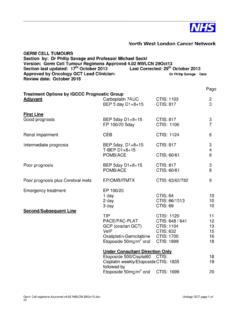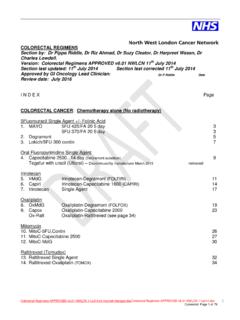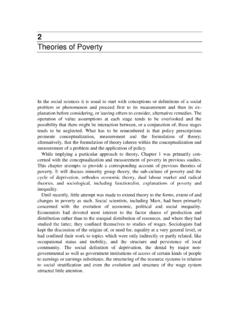Transcription of A guide to benefits and financial help for people …
1 A guide to benefits and financial help for people affected by cancer benefits rates apply April 2009 April 2010. 1. Contents Introduction to the benefits 2. help for people of working 5. help for 17. help for 21. help with housing 27. help with health 33. help with children's 43. 47. Loans and grants for other 55. More 60. Useful 66. Macmillan cancer 70. 75. cancer can be very expensive, but there are ways to ease the financial worries When you or someone close to you has been diagnosed with cancer , money might not be one of the first things you think about. But having cancer can be expensive in ways you may never have expected: you may have to pay for prescriptions, a special diet, child care or travel to hospital. If you are struggling to cope with the financial effect of cancer , remember that there is help available.
2 The aim of this guide is to explain what financial benefits are available and to show you how you can get this help . To make things even clearer, it may also be helpful to speak to an experienced benefits adviser or to call one of the useful phone numbers in this guide (see pages 66 to 69). We hope that, with the right advice and information, you will be able to get the help you need with your money problems allowing you to focus on what really matters. 2 Introduction to the benefits system The Department for Work and Pensions The Department for Work and Pensions (DWP) is responsible for social security benefits , such as Income Support and Attendance Allowance. The DWP has several agencies that handle these benefits , including Jobcentre Plus, the Pension Service and the Disability and Carers Service.
3 Jobcentre Plus is the agency for people of working age (16 to 65). You can use them to claim benefits or find work (or both). Your local office will be listed in the phone book under Jobcentre Plus, or visit their website If there is no Jobcentre Plus office in your area yet, your local benefits office will be listed in the phone book under social security. The Pension Service and the Disability and Carers Service have now been brought together into a single agency the Pension, Disability and Carers Service. The service is responsible for people of pension age, as well as those planning for their pension and nearing retirement. You can contact them by phone, fax, email or letter, with questions about your state pension or about claiming benefits for people of pension age, such as Pension Credit.
4 The service can arrange a home visit, or for you to visit your local office, if your query cannot be dealt with over the phone. The Pension, Disability and Carers Service is also responsible for disabled people and their carers and administers Disability Living Allowance, Attendance Allowance and Carer's Allowance. Your local office will be listed in the phone book or see There are two types of benefits available from the Department for Work and Pensions; means-tested benefits and non means-tested benefits . Introduction to the benefits system 3. Means-tested benefits (MT). These depend on your income and savings, and those of your partner. These are always non-contributory (see below). Non means-tested benefits (NMT). Non means-tested benefits can be either contributory or non-contributory: n Contributory benefits (C) These are based on contributions you have made to the National Insurance contribution scheme.
5 N Non-contributory benefits (NC) You can claim these even if you have not paid National Insurance contributions. You may find it useful to read the following guide produced by the Department for Work and Pensions: n A guide for disabled people , those with health conditions and carers (DHC1JP) includes details of financial and practical support available. There are also leaflets available giving more details of specific benefits mentioned in the guide above. These include: Attendance Allowance (AAA5 DCS). n Disability Living Allowance (DLAA5 DCS). n Carer's Allowance (CAA5 DCS). n Going into hospital? (GIHA5 DWP) what happens to your benefits and pension. You can ask for these leaflets and guides at your local office, or download them from There is also help available from other organisations.
6 These include your local authority (council) and HM Revenue &. Customs. For more information see . money, tax and benefits section. help for people of working age 5. Robert's story Robert, who is 48, was recently diagnosed with bowel cancer . He works full-time and lives on his own in a rented flat. Robert has 7,000 in savings. Robert had surgery and was undergoing a 16-week course of chemotherapy. The side effects of surgery and cancer treatment meant that Robert had great difficulty in looking after himself, and a simple task such as getting dressed was a slow and painful process. After contacting a benefits adviser, Robert found out that he was entitled to Statutory Sick Pay from his employer for up to 28 weeks, and Employment and Support Allowance (ESA) from the government after that.
7 Robert also applied for and received the following: Disability Living Allowance (care and mobility). Worth an extra a week Income Support Worth an extra a week Housing Benefit and Council Tax Benefit Amount depending on Robert's personal circumstances Income Tax refund Amount depending on Robert's personal circumstances Road Tax exemption Disabled Parking Badge Blue Badge Scheme 6 help for people of working age Because he was awarded Income Support, Robert also became eligible for: n free prescriptions n free eyesight tests and vouchers for his glasses n a full refund of his fares to hospital n free NHS dental treatment n free wigs and fabric supports. If Robert had not found out about his entitlements, he would have had to live on just a week.
8 By claiming the benefits he was entitled to, his income increased to a week. As Robert's case shows, people of working age are entitled to a wide range of benefits . If you fall within the 16 to 65 age group, it is important to explore all the following areas. Employment rights You may be covered by employment law if: n your employer dismisses you because of your illness n your employer does not pay you what you are entitled to n your employer discriminates against you in any way because of your illness. Under the Disability Discrimination Act, cancer patients are defined as disabled from the point of diagnosis. For more advice on your employment rights contact Macmillan cancer Support for a copy of Working through cancer , their guide for employees, or contact your local Citizens Advice (details will be in the phone book or see ).
9 For details of Citizens Advice Scotland, visit help for people of working age 7. Statutory Sick Pay (NMT/NC). Statutory Sick Pay is paid by your employer for up to 28 weeks of sickness. The standard rate of Statutory Sick Pay is currently a week. When your Statutory Sick Pay is due to end, you should check your entitlement to Employment and Support Allowance (see pages 8 to 9). How can I claim? Ask your employer, who is responsible for making these payments. Statutory Sick Pay is a legal minimum and if you qualify for it, your employer cannot pay you less. Occupational or company sick pay You may be entitled to this on top of Statutory Sick Pay check your employment contract. If you are self employed you can still apply for benefits . Your entitlement to any benefit will depend on your personal circumstances, income, savings, care and/or mobility needs.
10 Please contact a benefits adviser for advice. Incapacity Benefit (NMT/C or NC). Incapacity Benefit has been replaced by Employment and Support Allowance (EAS) for new claimants applying after 27 October 2008. Exisiting claimants on Incapacity Benefit will remain on the benefit for the time being. The plan is that all claimants will move over to EAS. over the next two years. Incapacity Benefit was paid to people of working age who had paid the relevant national insurance contributions in the relevant tax years. 8 help for people of working age Incapacity Benefit is paid at three rates: n Short-term lower rate of , for the first 28 weeks tax-free during this period). (. n Short-term higher rate of , for 29 to 52 weeks. n . Long-term rate of , for one year and over ( people who are terminally ill, or receiving the care component of Disability Living Allowance at the higher rate, can get the long-term rate of Incapacity Benefit after 28 weeks of sickness).
